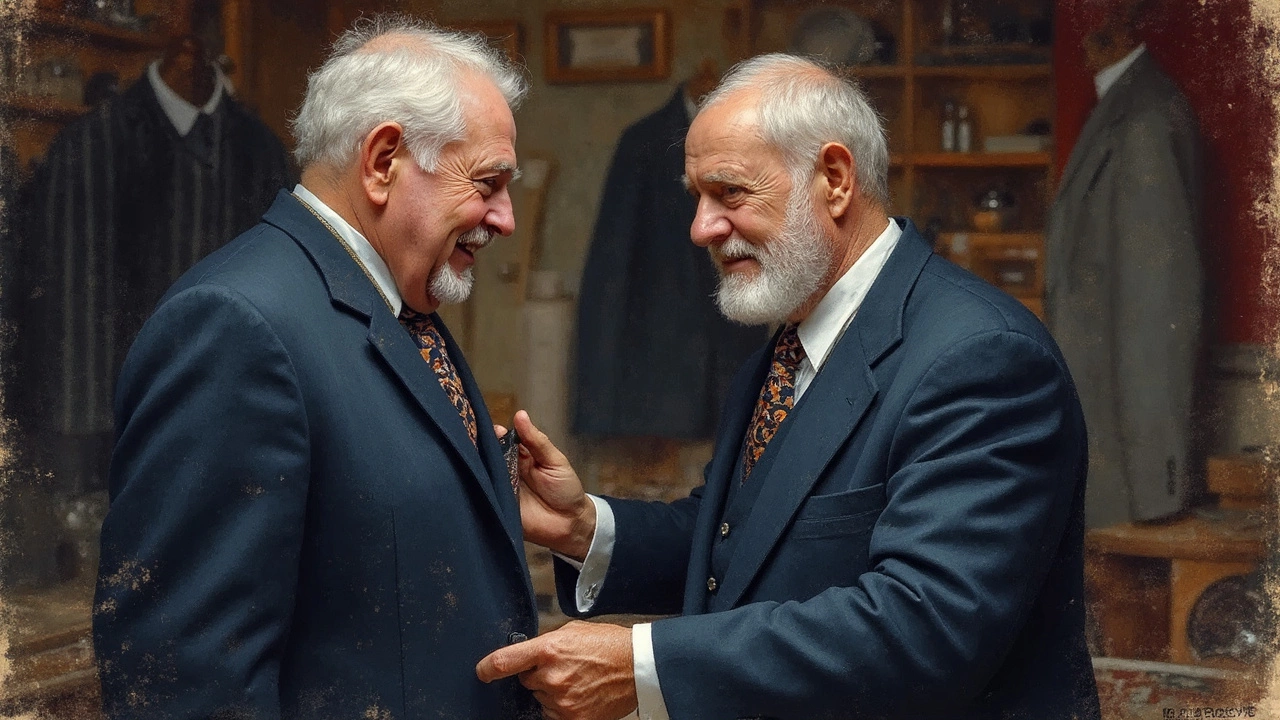In Ireland, where unpredictable weather and cultural elegance often meet, wearing the right suit can be a game-changer. But how do you tell a truly expensive suit from one that's just pretending? Let’s dive into the essentials.
First up, fabric. A top-notch suit usually has fabric that feels incredible to the touch. Think wool and cashmere blends that breathe well and keep you comfortable across ever-changing Irish climates. On the other side, cheap suits often use synthetic fibers that feel rough and cling uncomfortably.
Then there's craftsmanship. Quality suits feature impeccable stitching and are often hand-sewn by skilled tailors. This isn’t always apparent on first glance, so take a closer look at the seams and linings. A suit made with care will have smooth seams and a lining that stays put. Cheap suits, however, might show visible stitches or seams that don't quite align.
- Understanding Fabrics: The Backbone of Quality
- Craftsmanship and Construction
- The Importance of Fit: Personalized Touch
- Local Brands and Tailoring: Embracing the Irish Touch
Understanding Fabrics: The Backbone of Quality
When it comes to suits, the fabric is often what sets the Irish suits apart from the rest. It's a bit like choosing a dinner in Dublin; you'd want quality ingredients to ensure a top-notch meal. The fabric is the soul of a suit, and knowing your materials can save you from fashion mishaps.
Let's talk wool. Quality suits Ireland adore their wool. It’s breathable and naturally wrinkle-resistant, making it perfect for those marathon meetings or joyous weddings by the sea. A fine wool suit feels luxurious and can last quite a while if treated right. On the flip side, synthetic blends like polyester might seem cheaper, but they don't hold up the same way, especially in terms of breathability. Not ideal when those pub conversations get lively and the room heats up!
Cotton is another favorite, especially in spring and summer when the occasional sunny day pops up. It's light and comfortable but might wrinkle more easily than wool. In saying that, if you enjoy a relaxed yet sharp look, cotton is your go-to. Have you heard of cashmere blends? They're like the premium dessert at a top restaurant: a bit more costly but oh-so-worth it for the softness and warmth in cooler Irish months.
If you're looking for an easy fabric quality check, touch and feel can be your best friends here. High-end fabrics feel smoother and more consistent to the touch. Give the jacket a gentle scrunch; good quality will bounce back without a fuss. Also, check for natural shine; an expensive suit will often have a soft, sophisticated sheen rather than a cheap, flashy glare.
Although knowing fabrics is essential, don't sweat it if you can't remember all the details. Many tailors and shops around Ireland are experts in helping gents find their perfect match. Whether you're wandering through charming streets in Galway or exploring the vibrant districts of Dublin, local tailors will be more than happy to shed some light on this fabric mystery.
Craftsmanship and Construction
When you're trying to figure out if a suit is worth the investment, pay close attention to its construction. A well-constructed suit can stand the test of time and several Irish weddings or business meetings. If you're in Dublin and find yourself in a store like Louis Copeland & Sons, you'll notice that their suits boast a certain sturdiness and grace. But what makes this quality apparent?
The first thing to check is the stitching. High-quality suits often feature 'pick stitching' - tiny, barely noticeable stitches close to the edge of the fabric. These stitches are often done by hand, adding to the suit’s overall durability and aesthetic. In contrast, cheaper suits may have machine stitches that can be larger and uneven.
Another critical element is the interlining. Top-notch suits use a canvas interlining, usually made from horsehair, which helps the suit hold its shape over time. You’d struggle to find this in a cheap, off-the-rack number. A quick trick to check this is to pinch the suit fabric between your fingers; if you can feel a third layer in there, it’s likely a quality canvas interlining.
- Irish suits are traditionally known for their loose, flowing drape and sturdy construction, often tailored around local weather and style.
- Look for full-canvas or half-canvas constructions as opposed to fused ones, which are common in less expensive suits.
- Check the buttonholes. Hand-stitched buttonholes are a hallmark of excellent craftsmanship.
Finally, pay attention to the lining. In premium suits, linings are usually made from materials like silk or a high-quality synthetic blend for comfort and elegance. A cheap suit, by contrast, might have a polyester lining, which doesn't breathe well and can be uncomfortable.
All these factors combine to quote the Irish market price for quality without a regret. If you're in Cork or Galway, swing by a trusted local tailor, and have a chat. Those folks know their suits and can guide you like no other.

The Importance of Fit: Personalized Touch
Imagine buying the most expensive suits in Ireland, yet it feels like a potato sack draped over your body. Heartbreaking, right? That's because, at its core, a suit is all about the fit. Even an outrageously priced suit can look cheap if it doesn't sit right.
In Ireland, personal tailoring isn’t just a luxury—it's a cultural staple. Local tailors, from Dublin to Cork, offer alterations that transform a suit into a second skin. When buying a suit, even one off-the-rack from favorite spots on Grafton Street, a visit to your neighborhood tailor can make all the difference.
A great fit flatters your frame. Focus on these key areas:
- Shoulders: The suit's shoulders should hug your own. If they droop or bunch up, it's not your size. Shoulder pads shouldn't extend beyond your natural shoulders.
- Jacket Length: The end of a well-fitted jacket aligns with your knuckles when your arms are relaxed at your sides. Too long or too short and you'll look like you're borrowing someone else's suit.
- Sleeve Length: Your jacket sleeves should stop just above the wrist bone, revealing about half an inch of your shirt cuff. It’s a subtle detail with significant impact.
- Trouser Fit: Avoid the dreaded 'tent' effect. Trousers should be snug around the waist without squeezing, and break slightly over the shoes.
Think of it like this: a well-fitted suit is to a man what a gorgeous coat of paint is to a classic Irish cottage. It highlights strengths and disguises flaws, projecting confidence and style. Plus, investing in adjustments ensures your suit stays in rotation longer, always ready for events ranging from casual walks around Temple Bar to formal business lunches.
Local Brands and Tailoring: Embracing the Irish Touch
When it comes to choosing a suit in Ireland, it’s not just about fabric or fit. It’s about embracing the rich local culture and the unique touches that Irish brands bring to the table. Wearing a suit designed or tailored on Irish soil adds a layer of authenticity and style that stands out.
Take Louis Copeland & Sons, for instance. With a heritage that dates back to 1933, they’ve dressed some iconic celebrities. They’re renowned for their impeccable made-to-measure suits that capture the spirit of classic Irish elegance while ensuring exceptional modern trends. And then there’s Magee, hailing from Donegal, known for their stunning use of tweed—a fabric deeply rooted in Irish history.
Why should these local touches matter? Well, Irish suits often incorporate traditional patterns and materials, providing both quality and identity. As acclaimed fashion expert John Burke notes,
"Choosing an Irish suit isn't just a fashion decision; it's a statement of heritage and meticulous craftsmanship."
If you're considering tailor-made, Jim’s Tailoring & Custom Suits in Cork are known for their personalized service. They take the time to understand your preferences, ensuring your suit is as unique as you are. Plus, supporting local craft is always a good move, benefiting the community and celebrating Ireland’s sartorial tradition.
For those who love data, here's a snapshot of the advantages of local tailoring vs off-the-rack options:
| Feature | Local Tailoring | Off-the-Rack |
|---|---|---|
| Fit | Custom, perfect measurement | Standard sizes |
| Fabric Choice | Wide range | Limited |
| Cultural Elements | Incorporates Irish heritage | Generic styles |
So, next time you're on the hunt for a suit in Ireland, consider going local. It's a chance to wear something that's not only stylish and high quality but also a piece of Ireland’s story.
